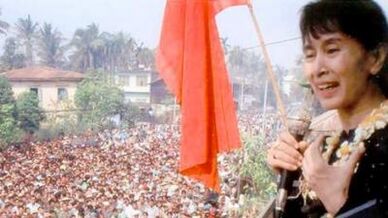Scarlet Revolution
This article is incomplete because it is pending further input from participants, or it is a work-in-progress by one author. Please comment on this article's talk page to share your input, comments and questions. Note: To contribute to this article, you may need to seek help from the author(s) of this page. |
| Scarlet Revolution | |||
|---|---|---|---|
| Part of the Bethausian transition to democracy | |||
Clockwise, from top:
| |||
| Date | 23 April 1993 – 19 August 1995 (2 years, 3 months and 27 days) | ||
| Location | Bethausia (nationwide) | ||
| Caused by |
| ||
| Goals |
| ||
| Methods | |||
| Resulted in | Opposition victory
| ||
| Parties to the civil conflict | |||
| |||
| Lead figures | |||
| |||
| Number | |||
| |||
| Casualties | |||
| Death(s) | 800 | ||
| Arrested | 1,684 | ||
The Scarlet Revolution, also recognized as the Yellow Peacock Revolution and the Bethausian Spring, was a series of demonstrations that occurred nationwide from 23 April 1993 to 19 August 1995. The event involved a sustained campaign of civil resistance and disobedience that originated from sparse student and political demonstrations that observed an increase in mass support, including elements of the Tatmadaw. The two former names of the Revolution originates from the prevalence of the yellow peacock and the color scarlet on headbands and the flags wielded by the protestors. The general nonviolent resistance brought about the Dissolution of the Royal Junta and the Abdication of Henry Louis consequently, ending the 27-year-long Second Union regime. Given the conclusion reached, the series of demonstrations is also referred to as the Fall of the Royal Junta, the Fall of Henry Louis/Wunna Kan, the Great Outcry, and the Great Democratization Movement.
The Revolution began with student demonstrations in Kengkaw and Sayangon in defiance of martial law following the extrajudicial arrests of opposition figures Aeindra Inzali Sein Myat and U Ye Zar Kaung and the exposure of the 1991 Crackdowns. Stretching from 29 April to 2 May 1993, the protests in these cities were brutally suppressed by the military and police force, and news of the crackdown was censored. On 16 June 1993, several Catholic and Protestant missionaries and volunteer workers from the Ingzua Region and Kachin State were interrogated and tortured for apparent sympathies towards Communist insurgents in Bethausian-occupied Lhossa, leading to another demonstration in Wainlaung two days later that was again violently suppressed. Small acts of civil disobedience occurred, and no major protests would occur until the wake of the 1994 economic crisis. Consequently, 1994 observed marches partaken by civilians, Buddhist monks, Christians, and Muslims in the wake of government austerity measures alleviating the effects of the 1994 economic crisis, such as in Maungtabin in South Ingzua, Raje in the Arakan State. The Junta co-opted powerful leaders of the opposition to compromise the negative socio-economic effects and arrive at a consensus for a limited democracy; the leaders included Thurein Wai, Tun Maung Pyae Zeya, Myint Myat, and Niclas Pyae Linn Pohl. During this period, only U Ye Zar Kaung was released. However, months of disagreement lead to most of the opposition leaders to either be ejected, as it happened with Thuerin Wai, or resign, as in the case of the rest of the aforementioned leaders. Fearing another violent suppression, the opposition resorted to sparse acts of civil disobedience. Arrests of prominent activists were resumed by the Royal Junta in order to weaken the opposition, and state media was heavily censored and did not reach foreign countries to propagate the illusion of internal stability. U Ye Zar Kaung was subsequently placed under house arrest.
A new development in the form of the 1994 Bethausian coup d'état occurred when disgruntled military officers attempted to oust the Royal Junta and temporarily seize control of the government for the release of Aeindra Inzali Sein Myat and restoration of democracy. It became poorly coordinated in the later stages, and with their failure to capture the king, prime minister, and the minister of the interior, they were apprehended and tortured. Another protest occurred in the streets of Kengkaw, Sayangon, and Maungtabin and various cities around the country, and despite the crackdowns, civil resistence persisted. With international pressure mounting, the Junta made the decision to release Aeindra Inzali Sein Myat from Khabein Prison on 23 February 1995 and free Kaung a day later. The Junta later announced on national televsion promising democratic reforms which was met with enthusiasm. Dialogue between the government and opposition reached a dead end with the Junta using the economic recovery as justification. Protests soon erupted and culminated in two violent events: the Chinmai University incident, which resulted in 6 deaths and wounded opposition leader Isabelle Aeindra Gerstäcker; and, the subsequent three day long protests and riots that resulted in 145 dead from the military's suppression. The casualties were underreported by state media, and Henry Louis ordered martial law on 25 July on grounds of a resurgence of communist insurgency.
Martial law was lifted on 30 July as an apparent sign that the Junta has restored order and the communist insurgency averted. However, the government ban on assemblies of more than five people was still in effect. Aeindra Inzali was placed under house arrest on 31 July for apparently disobeying the restriction, but it was discovered later that the move was politically motivated internally. Strikes and boycotts were initiated against government-aligned businesses, banks and media on 1 August. Demonstrations in Kengkaw and Sayangon commenced on 2 August. Altogether, these events constituted the beginning in what is to be known as the Great Outcry (also called the "August Democratic Struggle"). Aeindra Inzali, with the assistance of fellow party members and civilians, escaped from her compound on the night of the 2nd and arrived in Kengkaw on the 4th. Her appearance enabled an increase in mass support in the demonstrations in Kengkaw and Sayangon, which prompted the government to order more military units in both cities. In Kengkaw, the 15th Infantry Division refused to carry out the "Kill Order" issued by its commander on 5 August. The opposition's resilience galvanized mass support, even earning the defection of Mariannette, the Princess Royal of Bethausia and the 16th Strike Wing ordered to attack a defecting army unit. The demonstrations started up all over the nation, with participants originating from all walks of life, including the navy, air force, and police. On the night of 13 August, Prince William Edwardius defected to the opposition, which led the Junta to relent by ordering all military units to stand down and opening negotiations with the opposition leaders the next day. A plebiscite was scheduled for and held on 16 August 1995, and the "No" side won with 70% of the vote. Consequently, Henry Louis abdicates and the Junta is dissolved on 19 August.
The Revolution resulted in the end of the Second Union, and commenced Bethausia's transition to democracy. The dissolution of the Royal Junta enabled the return of a parliamentary democracy and previous civil liberties. The provisional government was established, with William Edwardius II succeeding Henry Louis as king, Aeindra Inzali as Prime Minister, and U Ye Zar Kaung as Deputy Prime Minister, which led to the establish the Bethausian Third Union. Although the military would hold a portion of political power until the conclusion of the FUA Crisis, the Revolution was widely seen as a victory against virtually three decades of rule by the military junta. The generally nonviolent nature of the Revolution, especially the August 1995 demonstrations, made news headlines internationally, lauding it as the "revolution that astonished the world" and the "revolution that relieved the world of another civil war."
Background
Rule of the Royal Junta
Economic problems
Bethausian occupation of Kyachindwin and Lhossa
1991 Crackdowns
Arrest of Aeindra Inzali Sein Myat and U Ye Zar Kaung
Events before August
First Sayangon demonsration (29 April-2 May 1993)
1994 Economic Crisis
Nationwide protests (18 March-18 April 1994)
Junta discussion with and co-opting of opposition leaders (19 April-10 August 1994)
Release of U Ye Zar Kaung (18 July 1994)
Purging and resignation of opposition leaders (11 August 1994)
Sparse civil disobedience and Junta arrests resume (11 August-14 December 1994)
Coup by the AFRM (15 December 1994)
Release of Aeindra Inzali Sein Myat (23 February 1995)
Royal Junta promises democratic reforms (27 February-19 July 1995)
Opposition discontent resumes (20 July 1995)
Shootout at Chinmai University (21 July 1995)
Suspected Communist infiltration led to the use of force, which including the use of bullets



